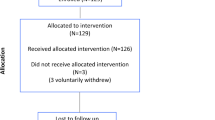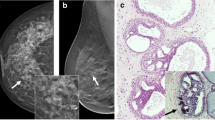Abstract
Background
In patients with a diagnosis of occult cervical cancer made on a hysterectomy specimen after surgery for a benign indication, lymph node assessment is crucial to determine treatment. We aimed to compare sentinel lymph node (SLN) mapping between patients with postoperative diagnosis of occult cervical carcinoma and patients with cervical cancer and uterus in situ.
Methods
A retrospective analysis of cervical cancer patients International Federation of Gynecology and Obstetrics (FIGO) stage IA–IIA disease undergoing laparoscopic SLN mapping was performed. Patients were divided into two groups: those with a diagnosis of occult cervical cancer made on a hysterectomy specimen (group 1) and those with a diagnosis of cervical cancer and uterus in situ (group 2). Tracers used for SLN mapping included technetium-99m (99mTc), blue dye, and indocyanine green. After detection and excision, the SLN was sent for frozen section analysis, and the planned surgical procedure was aborted in case of metastatic disease in favor of a chemoradiotherapeutic treatment.
Results
Groups 1 and 2 included 9 and 62 patients, respectively. Clinicopathologic characteristics were similar among the two groups. Overall and bilateral detection rates were 66.6 and 33.3 and 95.1 and 87 % in groups 1 and 2, respectively (p < 0.05). No false-negative SLNs were identified in either group, with a negative predictive value of 100 %.
Conclusions
SLN mapping in occult cervical cancer patients has lower detection rates compared to patients with uterus in situ. In these patients, proper management of their disease has already failed before diagnosis, and additional mistakes may definitely compromise attempts at cure.


Similar content being viewed by others
References
Narducci F, Merlot B, Bresson L, et al. Occult invasive cervical cancer found after inadvertent simple hysterectomy: is the ideal management: systematic parametrectomy with or without radiotherapy or radiotherapy only? Ann Surg Oncol. 2015;22:1349–52.
Jiang H, Qu L, Liu X et al. A comparison of laparoscopic and abdominal radical parametrectomy for cervical cancer or vaginal apex carcinoma and stage II endometrial cancer after hysterectomy. JSLS. 2013;17:249–62.
Covens A, Rosen B, Murphy J, et al. How important is removal of the parametrium at surgery for carcinoma of the cervix? Gynecol Oncol. 2002;84:145–9.
Pluta M, Rob L, Charvat M, et al. Less radical surgery than radical hysterectomy in early stage cervical cancer: a pilot study. Gynecol Oncol. 2009;113:181–4.
Frumovitz M, Sun CC, Schmeler KM, et al. Parametrial involvement in radical hysterectomy specimens for women with early-stage cervical cancer. Obstet Gynecol. 2009;114:93–9.
Jeon HW, Suh DH, Kim K, No JH, Kim YB. Lymphadenectomy alone is a feasible option in managing incidentally-detected early stage cervical cancer after simple hysterectomy without intermediate-risk factors: an application of the concept of less radical surgery. Anticancer Res. 2013;33:5135–41.
Gemer O, Eitan R, Gdalevich M, et al. Can parametrectomy be avoided in cervical cancer? An algorithm for the identification of patients at low risk of patients for parametrial involvement. Eur J Surg Oncol. 2013;39:76–80.
Schmeler KM, Frumovitz M, Ramirez PT. Conservative management of early stage cervical cancer: is there a role for less radical surgery? Gynecol Oncol. 2011;120:321–5.
Sedlis A, Bundy BN, Rotman MZ, Lentz SS, Muderspach LI, Zaino RJ. A randomized trial of pelvic radiation therapy versus no further therapy in selected patients with stage IB carcinoma of the cervix after radical hysterectomy and pelvic lymphadenectomy: a Gynecologic Oncology Group study. Gynecol Oncol. 1999;73:177–83.
Rotman M, Sedlis A, Piedmonte MR, et al. A phase III randomized trial of postoperative pelvic irradiation in stage IB cervical carcinoma with poor prognostic features: follow-up of a Gynecologic Oncology Group study. Int J Radiat Oncol Biol Phys. 2006;65:196–76.
Peters WA, Liu PY, Barret RJ, et al. Concurrent chmotherapy and pelvic radiation therapy compared with pelvic radiation therapy alone as adjuvant therapy after radical surgery in high-risk early-stage cancer of the cervix. J Clin Oncol. 2000;18:1606–13.
Papadia A, Remorgida V, Salom EM, Ragni N. Laparoscopic pelvic and paraaortic lymphadenectomy in gynecologic oncology. J Am Assoc Gynecol Laparosc. 2004;11:297–306.
Bogani G, Cromi A, Serati M, et al. Improving standard of care through introduction of laparoscopy for the surgical management of gynecological malignancies. Int J Gynecol Cancer. 2015;25:741–50.
Lécuru F, Bats AS, Bensaid C, et al. Sentinel lymph node in low stage cervical cancers. Current data. Quality assurance. Prospects. Bull Cancer. 2014;101:349–53.
Darlin L, Persson J, Bossmar T, et al. The sentinel node concept in early cervical cancer performs well in tumors smaller than 2 cm. Gynecol Oncol. 2010;117:266–9.
Rob L, Strnad P, Robova H, et al. Study of lymphatic mapping and sentinel node identification in early stage cervical cancer. Gynecol Oncol. 2005;98:281–8.
Rob L, Robova H, Halaska MJ, Hruda M, Skapa P. Current status of sentinel lymph node mapping in the management of cervical cancer. Expert Rev Anticancer Ther. 2013;13:861–70.
Alander JT, Kaartinen I, Laakso A, et al. A review of indocyanine green fluorescent imaging in surgery. Int J Biomed Imaging. 2012;2012:940585.
Rossi EC, Ivanova A, Boggess JF. Robotically assisted fluorescence-guided lymph node mapping with ICG for gynecologic malignancies: a feasibility study. Gynecol Oncol. 2012;124:78–82.
Schaafsma BE, van der Vorst JR, Gaarenstroom KN, et al. Randomized comparison of near-infrared fluorescence lymphatic tracers for sentinel lymph node mapping of cervical cancer. Gynecol Oncol. 2012;127:126–30.
Jewell EL, Huang JJ, Abu-Rustum NR, et al. Detection of sentinel lymph nodes in minimally invasive surgery using indocyanine green and near-infrared fluorescence imaging for uterine and cervical malignancies. Gynecol Oncol. 2014;133:274–7.
Ditto A, Martinelli F, Bogani G, et al. Sentinel node mapping using hysteroscopic injection of indocyanine green and laparoscopic near-infrared fluorescence imaging in endometrial cancer staging. J Minim Invasive Gynecol. 2015;22:132–3.
Di Stefano AB, Acquaviva G, Garozzo G, et al. Lymph node mapping and sentinel node detection in patients with cervical carcinoma: a 2-year experience. Gynecol Oncol. 2005;99:671–9.
Kato H, Todo Y, Minobe S, et al. Previous conization on patient eligibility of sentinel lymph node detection for early invasive cervical cancer. Int J Gynaecol Cancer. 2011;21:1491–4.
Meigs JV. The radical operation for cancer of the cervix. Am J Roentgenol Radium Ther. 1947;57:679–84.
Park JY, Kim DY, Kim JH et al. (2010) Management of occult invasive cervical cancer found after simple hysterectomy. Ann Oncol. 21:994–1000.
Ercoli A, Delmas V, Iannone V, et al. The lymphatic drainage of the uterine cervix in adult fresh cadavers: anatomy and surgical implications. Eur J Surg Oncol. 2010;36:298–303.
Karima AC, Derks M, Smit NN, et al. Lymphatic drainage from the cervix uteri: implications for radical hysterectomy? Gynecol Oncol. 2014;132:107–13.
Woelber L, Grimm D, Vettorazzi E, et al. Secondary sentinel node biopsy after previous excision of the primary tumor in squamous cell carcinoma of the vulva. Ann Surg Oncol. 2013;20:1701–6.
McCready DR, Ghazarian DM, Hershkop MS, Walker JA, Ambus U, Quirt IC. Sentinel lymph-node biopsy after previous wide local excision for melanoma. Can J Surg. 2001;44:432–4.
Gannon CJ, Rousseau DL Jr, Ross MI, et al. Accuracy of lymphatic mapping and sentinel lymph node biopsy after previous wide local excision in patients with primary melanoma. Cancer. 2006;107:2647–52.
Ariyan S, Ali-Salaam P, Cheng DW, Truini C. Reliability of lymphatic mapping after wide local excision of cutaneous melanoma. Ann Surg Oncol. 2007;14:2377–83.
Imboden S, Papadia A, Nauverk M, et al. A comparison of radiocolloid and indocyanine green fluorescence imaging, sentinel lymph node mapping in patients with cervical cancer undergoing laparoscopic surgery. Ann Surg Oncol. 2015;22:4198–203.
Holman LL, Levenback CF, Frumovitz M. Sentinel lymph node evaluation in women with cervical cancer. J Minim Invasive Gynecol. 2014;21:540–5.
Diaz JP, Gemignani ML, Pandit-Taskar N, et al. Sentinel lymph node biopsy in the management of early-stage cervical carcinoma. Gynecol Oncol. 2011;120:347–52.
Disclosure
The authors declare no conflict of interest.
Author information
Authors and Affiliations
Corresponding author
Rights and permissions
About this article
Cite this article
Papadia, A., Imboden, S., Fink, A. et al. Accuracy of Sentinel Lymph Node Mapping After Previous Hysterectomy in Patients with Occult Cervical Cancer. Ann Surg Oncol 23, 2199–2205 (2016). https://doi.org/10.1245/s10434-015-5066-2
Received:
Published:
Issue Date:
DOI: https://doi.org/10.1245/s10434-015-5066-2




